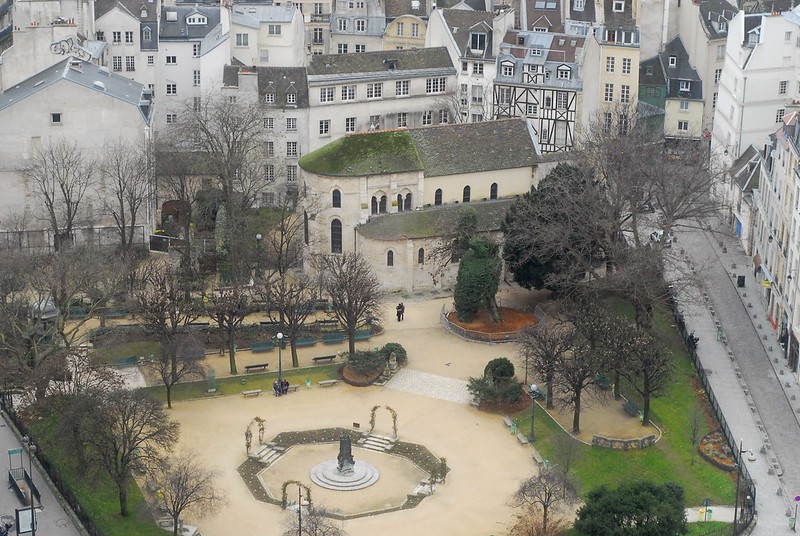In which we like the wallpaper
Published at 6:18 pm on May 14th, 2010
Filed under: Photobloggery.
Usually, when we go on holiday, it’s either an expedition in a roomy, comfortable tent, or a quick weekend trip in a Travelodge or similar. After all, when you’re going away to a city, you’re supposed to spend your time out exploring the town, not admiring the quality of the wallpaper. When we went to Rīga the other year, though, K picked out somewhere more individual for us to stay; and with this year’s trip to Paris, we found another hotel that was more than just a cluster of anonymous magnolia-coloured cells.
Read more...
Keyword noise: bed, bedside table, boutique hotel, furniture, hotel, interior decoration, Paris, photography, radiator, wallpaper, windows.
In which we go to a misty Paris
Published at 6:56 pm on April 30th, 2010
Filed under: Photobloggery.

Read more...
Keyword noise: angel, belfry, bells, catacombs, cathedral, France, Latin Quarter, Left Bank, Notre Dame, Paris, photography, Quartier Latin, Rive Gauche, sculpture, spire, stone.
Every so often, search requests come in for things like “disused stations on the Paris Metro”. I’m not entirely sure why, because this site doesn’t have very much content at all on that topic. All there is, in fact, is this post from a few years ago, which wasn’t really about disused Paris metro stations at all: it was more about all the various interconnection lines and mysterious secret underground depots that you can see from a passing train.
Read more...
Keyword noise: Arsenal, Croix Rouge, disused, Metro, Paris, railway, underground.
In which the family seem foreign
Published at 9:04 pm on October 17th, 2007
Filed under: Dear Diary, The Family.
My parents are not Norwegian. They’re English, have hardly ever left England, don’t speak any languages other than English. Until last week, my mother hadn’t had a foreign holiday for 35 years, and my dad had never had one at all.
Read more...
Keyword noise: English, Norway, Norwegian, Paris, stereotyping, The Mother.
In which we think about secret tunnels and the literature surrounding them
Published at 10:39 pm on September 17th, 2007
Filed under: Artistic, Geekery, Trains.
There are plenty of stories in literature about the nameless horrors that lurk deep within the bowels of the London Underground. It’s popped up in TV, too – on both Quatermass and Doctor Who in the 1960s – and in film. In books, the first example that comes to the top of my head is a short story by Jeremy Dyson, but there are certainly many more. There are stories of secret tunnels and secret trains, lines disappearing into disused stations and abandoned passages.
Read more...
Keyword noise: disused, disused underground stations, Doctor Who, Down Street, Jeremy Dyson, labyrinth, literature, London, London Underground, Neverwhere, Paris, Paris Metro, Post Office Railway, secret tunnels, underground.
In which we relax in a park
Published at 11:57 am on September 15th, 2007
Filed under: Photobloggery.
Photos from the Jardin du Luxembourg on a Sunday morning. Old men playing chess under a canopy. Hidden away in the groves of trees, a man practises moving a sword around. People sit on benches in the shade, enjoying the last weekend of the August holiday.
Read more...
Keyword noise: August, chess, holiday, Jardin du Luxembourg, Paris, park, summer, swordsman, trees.
In which we explain why we were in France
Published at 6:52 pm on September 2nd, 2007
Filed under: Dear Diary.
Talking of Catherine and Arnaud, incidentally: they were the reason I was in France taking photos of over-priced salad cream last week. They were having a party; not an anniversary party, but a housewarming, or crémaillaire. That word, apparently, relates to an ancient French custom of hanging up a butter churn when moving into a new house. So I’m told, anyway: my French really isn’t up to much.* If you want to see photos, though, you can do.
Read more...
Keyword noise: crémaillaire, France, friends, holiday, housewarming, Paris.
In which we study the markup on an import
Published at 9:38 am on August 29th, 2007
Filed under: Photobloggery, Unbelievable.
This was seen in the large Parisian department store Galaries Lafayette* the other day, in the “Epicerie Britannique” section of the gourmet foodhall:
Read more...
Keyword noise: British, Epicerie Britannique, expensive, food, France, Galaries Lafayette, Heinz, import, Paris, pricing, salad cream.
In bed last night, and starting to drift off to sleep. Today In Parliament is on the radio, because it’s so boring it helps me sleep faster. Suddenly: bleep. “Grrr,” I thought, “I’ve forgotten to switch my phone off.” I stumbled out of bed, found it, and looked at the screen.
Read more...
Keyword noise: Paris, weddings.

 Home
Home
 Newer posts »
Newer posts »